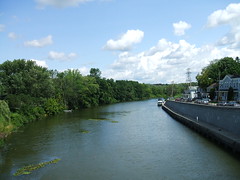When the people of NY state agreed to build the Erie Canal (early 1800's) they began to connect the resources of the Great lakes region (ore, timber, furs, mfg goods, etc) to NYC harbor, one of the world's great crossroads of trade.
The Erie Canal connected to the Hudson River, which flowed into NY harbor.
Wealth was created for people all along the Hudson valley and along the almost 400-mile length of the Erie Canal. The wealth of Great Lakes farmers and traders was also increased. Most of all, it helped the harbor at NYC become one of the world's richest ports.
Map sketch -
* 5 Great lakes (don't foget Mrs. Smheo)
* 6 states (the 5 states surrounding NY)
* Atlantic
* Canada
- Map quiz, 13 items, on Thurs.
How Louisiana and Shreveport could improve their practice of Water makes Wealth:
1. Develop the shores of Cross Lake. Improved parks and launch sites could bring tourism and improved quality of life for locals. Example? See Lake Ouachita or Lake Catherine in Arkansas.
2. Develop the final segment of I-49, a modern Erie Canal.
3. Continue development on the shores of the Red River.
Vocab:
The late Ted Kennedy was an august senator from Massachusetts.
Here the word august means "honored," "important."
Wikipedia:
The Erie Canal is a man-made waterway in New York that runs about 363 miles from Albany on the Hudson River to Buffalo at Lake Erie, completing a navigable water route from the Atlantic Ocean to the Great Lakes. First proposed in 1808, it opened[1] on October 26, 1825.
It was the first transportation system between the eastern seaboard (New York City) and the western interior (Great Lakes) of the United States that did not require portage, was faster than carts pulled by draft animals, and cut transport costs by about 95%. The canal fostered a population surge in western New York state, opened regions further west to settlement, and helped New York City become the chief U.S. port.
skip to main |
skip to sidebar
For students and parents who love education and exploration of the social sciences . . .
Search This Blog
Followers
Blog Archive
-
▼
2009
(379)
-
▼
August
(38)
- This week's music in World Geography: early jazz f...
- Graphing US demographics: ethnic breakdown
- The background of place names such as York
- River studies: journey up the Hudson with a NY Tim...
- A highly-recommended source for Magnet social stud...
- Project due Tues, Sept 8: Comparing the Erie Canal...
- Water giveth, water taketh away: week of Aug 31 to...
- Water and wealth: the story of the Erie Canal
- Matterhorn: The Alps IMAX film opening September 5...
- Longitude: what if the GPS satellite is out of com...
- A suburb of London called Greenwich, England: Lati...
- The Hydrologic cycle: condensation, precipitation,...
- Rivers equal wealth
- Ramadan: across the globe, one billion people are ...
- Latitude & Longitude: a review of the geography cl...
- Pratt Industries paper recycling plant on the Red ...
- The culture of the Miss River valley: Raising Cane...
- When a project or an essay is due via Google Docs ...
- A slow-moving internet: the Mississippi River and ...
- Preventing unwanted bleeding: the rubric for essay...
- Choctaws: one of the Native American tribes that m...
- Mr Mimal, mnemonics and map quizzes
- Discriminating between the avocado that needs more...
- From Minnesota to the Gulf of Mexico: the Mississi...
- Thirsty issues in your future: water supplies and ...
- Parent signature to show awareness of Mondotrudeau...
- The value in geography class is not in the facts
- An overview of Trudeau's world geography class in ...
- Your questions and input are valued in World Geogr...
- Personal computer classroom policy
- Typical Open Notes quiz: Obama biography
- Geography class homework: reading the notes posted...
- Scrumptious to bizarre: Comparison essay guidelines
- Establishing a gmail.com account for submitting pa...
- World geography / Robert Trudeau / materials 09 - 10
- Geography class syllabus / unit schedule 09 - 10
- Caddo Schools' calendar for 09-10
- LSUS Animation & Visual Effects open house Mon, Au...
-
▼
August
(38)

